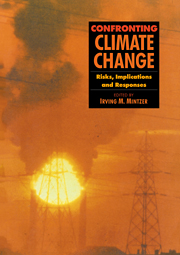Book contents
- Frontmatter
- Contents
- Foreword
- Acknowledgements
- List of Reviewers
- 1 Living in a Warming World
- I The Science of Climate Change
- II Impacts of Global Climate Change
- 7 Future Sea Level Rise: Environmental and Socio-Political Considerations
- 8 Effects of Climate Change on Food Production
- 9 Effects of Climate Change on Shared Fresh Water Resources
- 10 Effects of Climate Change on Weather-Related Disasters
- 11 The Effect of Changing Climate on Population
- III Energy Use and Technology
- IV Economics and the Role of Institutions
- V Equity Considerations and Future Negotiations
- Annex I
- Annex II
- Glossary
- Index
10 - Effects of Climate Change on Weather-Related Disasters
Published online by Cambridge University Press: 06 January 2010
- Frontmatter
- Contents
- Foreword
- Acknowledgements
- List of Reviewers
- 1 Living in a Warming World
- I The Science of Climate Change
- II Impacts of Global Climate Change
- 7 Future Sea Level Rise: Environmental and Socio-Political Considerations
- 8 Effects of Climate Change on Food Production
- 9 Effects of Climate Change on Shared Fresh Water Resources
- 10 Effects of Climate Change on Weather-Related Disasters
- 11 The Effect of Changing Climate on Population
- III Energy Use and Technology
- IV Economics and the Role of Institutions
- V Equity Considerations and Future Negotiations
- Annex I
- Annex II
- Glossary
- Index
Summary
Editor's Introduction
From the beginnings of history, human societies have been rocked by the shocks of weather-related disasters. Hot spells, cold snaps, hurricanes, typhoons, wind storms, droughts, and floods have killed people and devastated communities. The brief but painful moments of disaster — and their lengthy aftermaths—have long been the subjects of poems, folktales, novels, and historical writing. Among non-weather-related hazards, only earthquakes have killed or displaced so many people in such brief and bitter episodes.
With or without climate change, the precise timing, frequency and location of weather-related disasters are among the most difficult things to predict. We do not now (and perhaps can not ever) know when the next major disasters will occur. Only one thing is certain: extreme weather events will continue to menace civilization in the future, as they have in the past.
The situation may become more complicated in the future, however. Climate model studies indicate that a global warming resulting from the buildup of greenhouse gases will not be evenly distributed around the planet. The warming will be amplified in high-latitude regions to two or three times the global average effect. The temperature increase in the tropics is expected to be only 50-75% of the global average warming. This differential warming effect will reduce the thermal gradient from equator to poles, shifting the traditional patterns of winds and ocean currents. Some analysts believe that this change in air and ocean currents will increase the frequency of extreme weather events, and shift them, in some cases, to new locales.
- Type
- Chapter
- Information
- Confronting Climate ChangeRisks, Implications and Responses, pp. 141 - 152Publisher: Cambridge University PressPrint publication year: 1992
- 11
- Cited by

